Hot Spring
Activity
Local Food
Nostalsy
Health
Relax
Japanese Experience
Sightseeing
Tradition
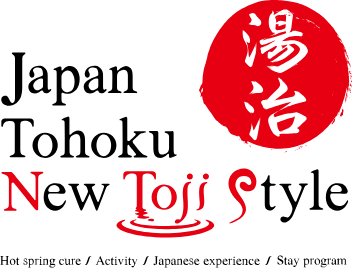
Tohoku, Hot Springs, Toji Hot Spring CureTohoku is a wonderful place where bountiful nature, beautiful scenery of the four seasons, various traditional local dishes, and overflowing kindness of good
old Japan still remain to this day.
Tohoku is also one of the leading hot spring areas in Japan, having many unique, well-known hot springs with a deep history that represents Japan.
Hot Spring Health ResortsIn Japan, a therapeutic bathing method known as toji (hot spring cure) exists since ancient times. This unique toji culture continues to this day, and many of these hot spring health
resorts still remain in Tohoku. In these resorts, you can feel the charming culture and spectacle that preserve the legacy of the past.
Tohoku has built a unique culture amidst the blessings of the bountiful nature and the harsh day-to-day life caused by heavy snowfall. The toji culture, Tohoku’s unique history and culture that still exists now, is also a part of this.
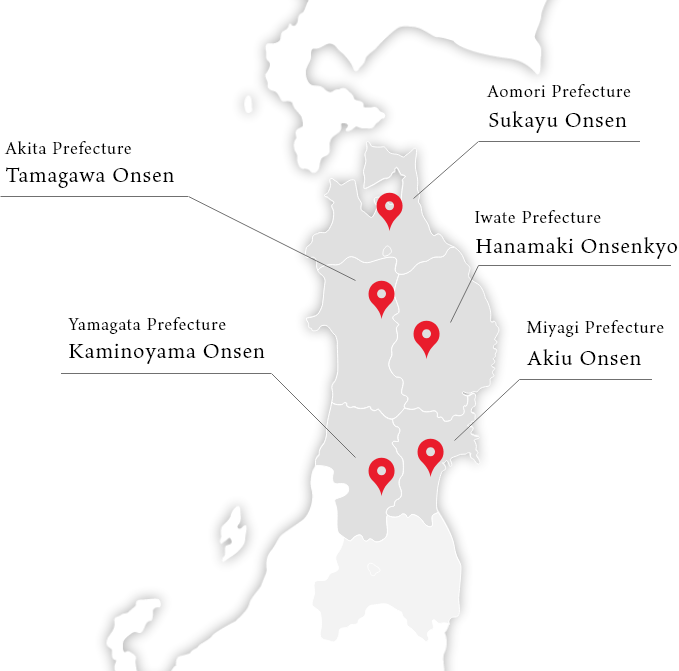
It has been said that immersing in a hot spring improves your metabolism and blood circulation thanks to the heat, water pressure, buoyancy, and other various factors. It also has been said to have detoxification
effects. Soaking in a hot spring also helps you relax and calm your mood, alleviating exhaustion.
Take a bath in a hot spring in the proper way that is good for your body, take a leisurely walk in the forest or move your body in amidst Tohoku’s great nature, eat healthy local dishes and Japanese cuisine, get in touch with
traditional crafts and culture to stimulate your curiosity, have an enjoyable interaction with the locals, and immerse in the Japanese spectacle and scenery.
Life in Tohoku with toji that awakens revival and makes your body and heart happy.
Now, we give a new form to the toji culture that has continued since the Jōmon period.
Stay at a famous hot spring, towards a journey of revival in contact with the hot spring life.
With hot springs as the hub, make your body and heart healthy, enjoy the charms of Tohoku, and experience Japan’s wonderful toji culture with the new toji style.
Toji originally started when people with chronic disease or farmers during slack season stayed at a hot spring for a long time for healing purposes. Toji has been practiced since ancient times, with its name
originating from tō of yakutō (medical bath) and ji (chi) from chiryō (cure). It was performed as an attempt to cure diseases through hot spring therapy by immersing in hot springs or drinking the hot spring water.
It is said that most of the hot springs were discovered by finding injured animals healing their wounds with the gushing hot water or from the discovery by high monks. Use of hot springs in Japan that remains in records date back all
the way to 1,300 years ago. In the Iyo no Kuni Fudoki (records of Iyo Province), Prince Shōtoku made an imperial visit to Iyo Hot Springs and built a monument in the year 596. The Chronicles of Japan also mentioned an imperial visit by
the emperor and the imperial family to the hot springs in the seventh century, and due to the long period of the visit, it is believed that this visit was done to practice toji. As time passed, the practice gradually spread to the
noble, monk, and warrior classes, and then spread widely to the common people during the Azuchi-Momoyama period until the Edo period. People started to go to hot springs to carry out toji during health resort therapy or a leisure trip.
Scholars and doctors also began to perform academic study on hot springs around this time. Various researchers discuss about the temperature, trait, water quality, and bathing methods of hot springs.
Many hot spring health resorts still remain in Tohoku today, and the many methods to enjoy toji including the long-term, self-catering stay as the traditional hot spring therapy, toji visits that also serve as a sightseeing trip, and
short term toji are spreading to various ages.

Experience Hakkōda/Shirakami-Sanchi trekking, Japanese culture, and life in Tsugaru
Aomori Prefecture
Acidic spring
Sulfur spring
Located 900 meters above sea level in the Hakkōda Mountains, Sukayu Onsen is a hot spring with over 300 years of history.
It is famous for its stimulating acidic water and the special 1,000-person Hiba bath, a 160-tatami (244 square meters) large bath made entirely out of Japanese cypress that is said to be able to hold 1,000 people at once. During your
stay at our hot spring, you can also enjoy the Hakkōda Mountains and Shirakami-Sanchi trekking, Japanese culture, the life at Tsugaru, and various festivals.

The world heritage Hiraizumi and country living, nature and cultural activities
Iwate Prefecture
Simple hot spring
Hanamaki Onsenkyo is home to 12 hot springs. Osawa Onsen, a hot spring inn loved by many literary persons for its simple, nostalgic mountain village scenery that looks like a landscape painting, historical
buildings with thatched roofs, and furnishings.
And Namari Onsen, a hot spring health resort famous since ancient times for its natural rock hot spring known as the deepest one in Japan, made by carving out natural rock. Stay at Hanamaki Onsenkyo and enjoy sightseeing around the
world heritage Hiraizumi, experience the country living, and do activities in nature and cultural experiences. During winter, experience walking with snow shoes and the life in a snow country.
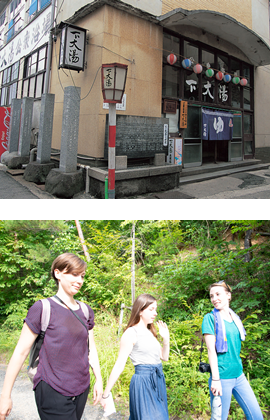
Kurort health walk, Shugendo and Yamabushi, winter activities, life in a snow country
Yamagata Prefecture
Chloride spring
Sulfate spring
Established over 560 years ago, it is said that this hot spring started when the priest Gesshu found a crane with a wounded leg that flew away after it healed its wounds with the water gushing from the swampland.
The smooth, hot water of this gentle hot spring is safe even for babies, and it is known as the "hot spring of beauties" with its great heat and moisture retaining properties.
A health walk with the Kurort course can also be enjoyed, acknowledged by Munich University, that utilizes Kaminoyama's topography and climate factors based on scientific foundation. Other activities that can be enjoyed include Zaō trekking, shugendo and yamabushi in the three mountains of Dewa, and foot bath at 5 locations around the city while looking at the snow, and snow activities and other cultures and history that you can only experience in a snow country during winter.

Strong acidic spring that is rare in Japan, the "miracle hot spring" with highly effective properties
Akita Prefecture
Acidic spring
Chloride spring
This hot spring was known as the "deer hot spring" because it was found when a matagi hunter saw a deer that healed its wounds here. It is well-known as the best strong acidic spring as well as the spring with the most water output from a single spot in Japan. Furthermore, the stone sauna utilizing heat from bedrock radiates radium radiation which improves blood flow, raises immunity and natural healing power, and give anti-aging effects.
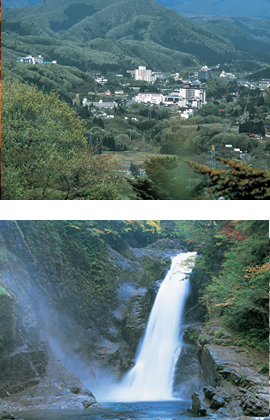
One of the imperial household's three hot springs of Japan, loved by Sendai's ruler, Date Masamune
Miyagi Prefecture
Chloride spring
Akiu Onsen’s long history goes back all the way to the Kofun period. It has been loved by the people as a recuperation spot since ancient times with its magnificent nature and wonderful hot spring. The 29th emperor, Emperor Kinmei (531-539) made a Waka poem to express the effects of this hot spring, "It’s a mystery how my skin became clear after offering this spring to the court." This hot spring flourished as a famous hot spring throughout generations.
